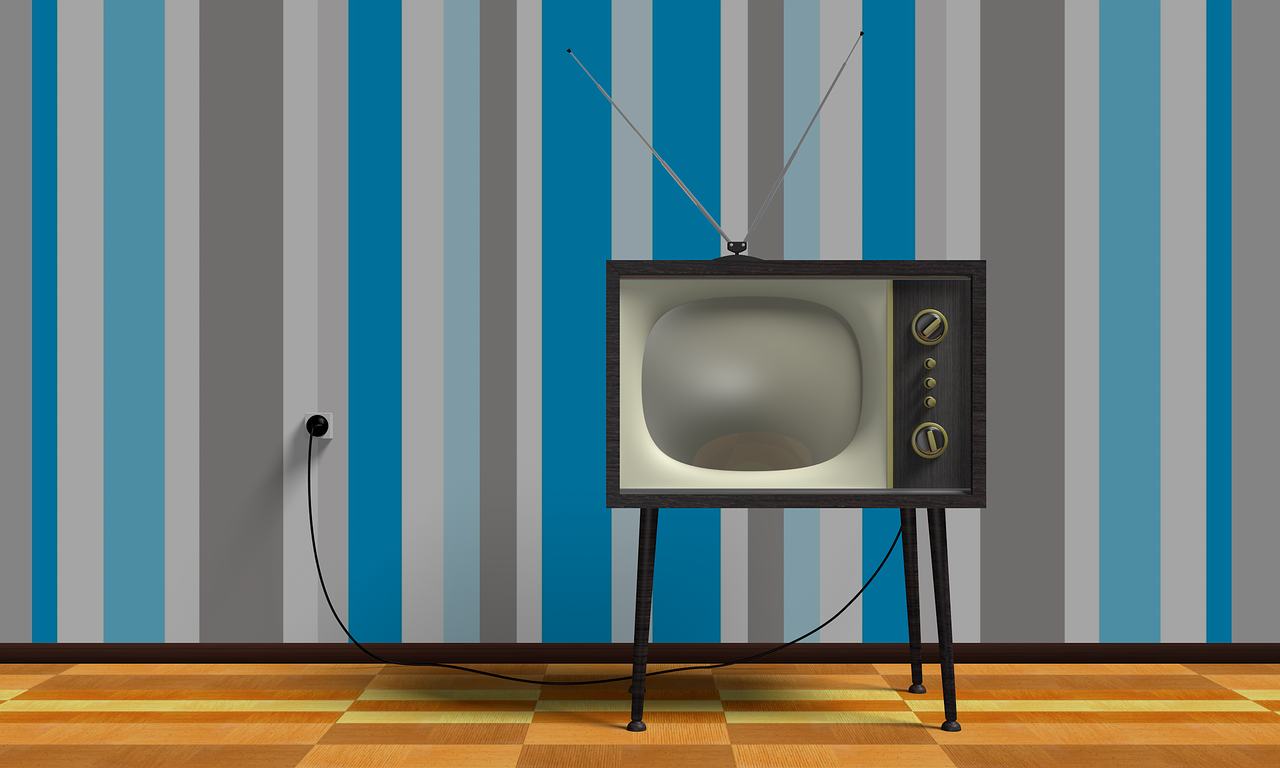In 2017, a billboard mysteriously popped up across Manhattan and Los Angeles. The black text on the stark white background said nothing but, “NETFLIX IS A JOKE,” and ignited vociferous speculation. Weeks later, Netflix came clean: the billboards were a publicity stunt – a teaser for a wave of stand-up comedy releases. Brilliant marketing strategy.
Retrospectively, though, the proclamation seems a bit prescient. Netflix and its peers are all treated at best as a joke and, at worst, a villain. The words, “I finished Netflix,” were an international pandemic meme, and no one was sure whether the joke was on them or us. Is streaming Netflix compulsively fun? Or is Netflix and its bedfellows a modern-day boogeyman?
Both the villain and the jester of the art world, television has always faced severe criticism. It’s been accused of everything from making us fat to making us dumb and, sadly, there’s good evidence to support both contentions. But TV is simply a tool. And like any other tool, it can be used in both harmful and helpful ways.
Television is Trouble
We, as a society, are terrible at managing our innovations. Like throwing spaghetti at the wall to see what sticks, we invent a new technology and release it out into the wild to wreak havoc instead of anticipating its dangers and adjusting. (I’m looking at you, social media.)
People have been worrying about the effects of technology since the beginning of recorded time.
In the 16th century, the invention of the printing press was expected to result in information overload and overwhelm the masses. When radio was introduced, it was accused of muddling the minds of youth – causing distraction from reading and drops in school performance. Television was greeted with the same trepidation, though the NY Times had a different take, declaring that it would never be more popular than radio because “no family has time to sit in front of a TV in the evenings without using their hands to do work.”1
All of these predictions missed the mark by a longshot. Books democratized education, radio actually improves focus when used thoughtfully, and TV…well, nearly every family gathers together around the TV.
But other, more serious consequences have emerged and TV can be trouble, indeed.
“The dose makes the poison.” – Paracelsus
Technology addiction is real and streaming services like Netflix are actively manipulating viewers to stay tuned. A 2013 article in the Journal of Behavioral Addictions set the prevalence of TV addiction at 10% in the US. Just for context, this is higher than the rate of alcoholism.
Other criticisms suggest that high usage leads to negative health effects, body image issues, decreased social interaction, and a fundamental distraction from ourselves – our needs and personal development. Because a power structure composed primarily of white people decides which television shows to produce and, therefore, proliferates a white worldview, social justice issues are also at stake. People of color don’t see themselves reflected back in any form of media frequently enough.3
These issues are real and they are serious. And yet…
Automobiles kill people daily, harm the environment, and congest our cities. We acknowledge those truths and work to decrease the impact of these drawbacks while still appreciating the ease and pleasure these tools bring to our lives.
Perhaps it’s also time to give television its due while attending to its concomitant societal ills.
Television is an Art Form
Television is an art form and we’re living in its golden age.
In the early days, there were three major channels, few shows, and series repeats filled much of the air time. The goal was to appeal to as broad an audience as possible, dumbing down and neutralizing content in a way that often led to flat scripts and dull performances.
Now, there’s content galore. The medium has countless outlets among zillions of traditional stations, cable channels, streaming services, and global access. There are at least twenty-two TV genres, ranging from news to anime. There’s something for everyone, nearly everywhere, at all times.
The upheaval and steep competition in the industry have increased the stakes. The players, vying for eyeballs, are always on the hunt for the next great idea and invest billions in production. Apple TV+ alone reportedly has budgeted six billion dollars to invest in the production of TV shows and movies for their streaming service.
And services are looking to generate passion in many different niches. Established and respected screenwriters are serializing movie scripts because there is so much more demand. And emerging talent – folks who could never get a foot through the door a decade ago – are being sought out and finding their niche. The breadth of writer diversity is reflected in series that teach us about different countries, cultures, races, and preferences.
To name but a few, consider the worldwide popularity of:
- a low-budget Welsh thriller (Keeping the Faith),
- a Canadian comedy about a multigenerational Korean-Canadian family (Kim’s Convenience)
- a British millennial trauma-drama with a predominantly Black cast (I May Destroy You), and
- a love-letter to the 1980s NY LGBTQ underground drag ball culture scene (Pose).
This is truly the golden age of TV.
Television as a Force for Good
One way of mitigating the harms of a tool is to ensure that it’s used in a helpful way. That starts by recognizing TV’s power for positive impact. Research and anecdotal experience demonstrate the ways TV contributes to the common good.
Social Connection
Entertainment is enriching. Having a transcendent experience, where you “enter the reel,” to live a different life in a different world has intrinsic value.
TV also has the potential to build social connections. Whether discussing ‘the soup nazi’ from Seinfeld or warning that “winter is coming” (Game of Thrones), TV provides us with a common language that forges connections between strangers.
Matthew Ball notes that “a TV show has only one version that lasts forever and is infinitely repeatable with 100% consistency.” That staying power makes it a touchstone – something individuals and groups alike can return to when they need a fix of a particular feeling or time.
Research has shown that TV can also act as a social connection surrogate, according to psychologist Kate Sweeney. “Social connections with TV show characters can actually serve as a surrogate for people…it’s really an amazing tool that we can use to help ourselves and to kind of replenish and feel connected, even if we can’t be with real people. You find it kind of tricks the brain.”1
Learning & Personal Development
Documentaries have always been an educational resource and, now that they’re available at home and in series form, we can digest new information more deliberately.
We can also learn psychological skills from fiction. “TV shows actually can really help build your empathy skills, because you’re following this story. And it kind of takes you step by step on how to relate to other people,” says Sweeney. “Even if you’re not around people during this time [the pandemic]…you can be building your patience just by building your empathy and engaging with narratives that are really compelling and practicing connecting with characters. And it’s fun.”
The possibilities of intentional learning are boundless. In a remote community on the banks of Lake Atitlan in Guatemala, I met a woman who learned English in part by watching American soap operas. In this isolated part of the world, where villagers in one town don’t even speak the language of the villagers in the next, this woman founded a cooking school, opened it to tourists, and supports herself, her family, and a growing community of artists. Watching TV didn’t accomplish this alone, but it certainly played a part.
Creativity Booster
Steve Jobs once said, “Creativity is just connecting things.” In that sense, a novel TV show is potentially a kind of particle accelerator. Exposure to creative ideas has been shown to generate further creativity. That’s what brainstorming is all about. Watching creative TV can generate creative ideas. Your own ideas, bouncing off an inspirational show, can lead to innovation.
Where No One has Gone Before
Star Trek, a “space western” that premiered in 1966, was a paradigm-shattering series that invited viewers to imagine a diverse, utopian future founded on equality, cooperation, and peaceful exploration. George Takei, a Japanese-American actor and the (unfortunately) mini-skirted Nichelle Nichols, an African-American actress, made history and set an industry-rattling example of inclusion.
Episodes focused on racial discrimination and social injustice set a new standard for the experience of TV. As a 7-year old, watching a rerun of ‘Let That Be Your Last Battlefield,’ ignited a firestorm of political thought in me that resulted in the production of a school newspaper within a year.
In that episode, the last two members of a planet destroyed by a race war continued to spew racial hatred with the aim of mutual destruction. The crew was at a loss to determine how these races differed. In fact, they seemed to look exactly alike: both races were half white and half black. It turned out that one race was white on the right and black on the left. For the other race, the skin color was reversed. The episode was heavy-handed and the un-special effects were atrocious (it was produced in 1969!). But the message was received by this little kid: Our differences are smaller than we perceive and persecuting each other over those differences is insane.
“Insights and big ideas result from collisions of ideas from different domains and disciplines, smashing together at a later point in time to birth an “Idea Baby.” – Tim Ferris
The technological impact of this series was equally profound. Star Trek predicted a slew of today’s technologies including tablet computers, flip phones, hyposprays, replicators, voice-interface computers, and Bluetooth headsets. The list goes on and on.
A whole generation of scientists was birthed by this one TV series, determined to invent the tech that they first encountered on Star Trek.
Star Trek was the grandfather of current creative TV, designed to stimulate, educate, and generate social cohesion. When viewers fell in love with a Vulcan, empathizing with a broader scope of humans became easier. A multi-racial cast of commanders delivered a subtle social commentary that quietly instigated change.
The 21st-century beneficiaries of this trailblazer – including spin-offs with truly special effects and deeper exploration of social issues – carry these lessons forward. (I extol the virtues of modern TV here, including a look at Discovery and Picard.)
The Verdict
When someone’s deriding TV as if it’s the harbinger of evil (or evil incarnate), they’ve revealed something important to me: they’re based on a dualistic mindset, aren’t able to appreciate the range of possibilities (and beauty) in everything, and are choosing to miss out on the subtleties of life.
TV, like so many things, is a tool. Used well, it’s a comfort, a resource, a learning system, a friend, an attitude-adjuster, a philosopher. Unchecked, it may become an addiction, a means of checking out, a relationship disrupter, and a distraction.
We do need to regulate this industry to mitigate its harms. At the same time, I’m here to embrace its charms.
My advice: revel in it. But not for too long.





0 Comments